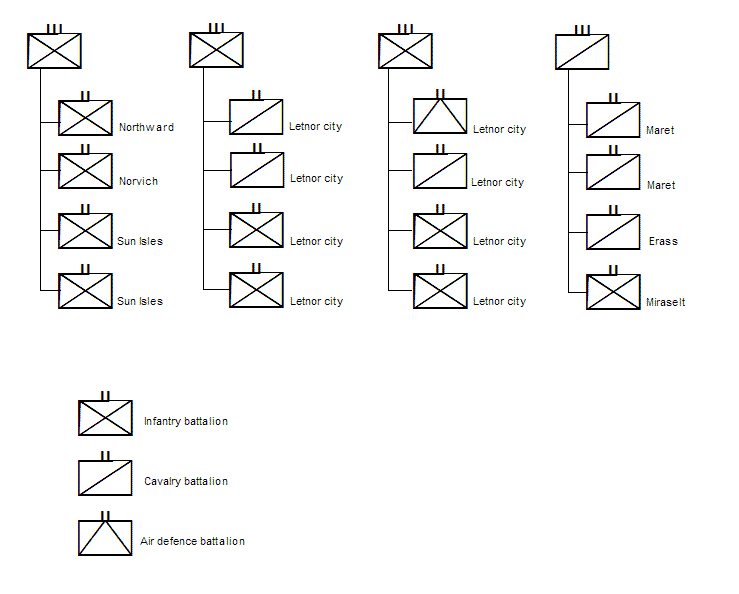Information about the armed forces of the Mid-Alandir Alliance, and the Royal Letnorian Army.

The headquarters of the Letnorian army is in, unsurprisingly, Letnor city. The leader of the army is General ?, the second in command is dowager-king Robert. Major combat support departments are headed by a colonel and are logistics, intelligence and personnel/training. Naval logistics is sufficiently specialist to have it's own structure.
The Letnorian army is made up of 4 regiments, each regiment led by a Colonel. Regiments are primarily an administrative and logistical grouping, and it is rare for an entire regiment to be in one spot. If a regiment is deployed, it normally means two battalions are on garrison duty, one acts as a mobile force, and one is on leave or traveling. A regiment is approximately 2000 soldiers. Commanding a regiment is a significant political role, and so is led by a major noble.
The battalion is the backbone unit of the Letnorian army, and is smallest unit assigned an independent command, such as a deployment to a region. Each battalion is commanded by a major, and has a nominal strength of 500 soldiers. A major is assisted by several captains, being the heads of operations, logistics, personnel, and a head chaplain. Reaching the rank of major grants a knighthood, if not already held. Due to mobility requirements, a battlion normally consists of entirely cavalry or infantry. When Letnor develops mounted infantry, then infantry companies will be cross-attached to calvary companies to form combined arms unitsand this limit will be relaxed.
There are 4 companies to a battalion, with a nominal strength of 100 soldiers per company. Each company is led by a captain. One of the companies in a battlaion is the headquarters company, with only security forces/gendarmeries/military police rather than front-line combatants. Companies are not deployed for indepdendent commands, such as far away from higher authority.
A squad is comprised of approximately 25 soldiers, led by a knight or a lieutenant. These soldiers are frequently men-at-arms provided by the knight. A lieutenant is a non-knighted officer, who lacks the additional social abilities and restrictions of knighthood, such as the right to carry arms at all times.
Individual warships are commanded by captains, with an equivalent rank to a land captain. Non-warships, or minor warships, are led by commanders.
The entire navy is still fairly small at 12 twelves ships, and is led by an Admiral, who commands two commodores leading each squadron. While small, the navy covers an extensive area, and so logistics and suppply ships are a serious concern. Letnor's first purpose-built office building, the Admiralty, houses the lieutenants who oversee these efforts.
Deployment - by unit